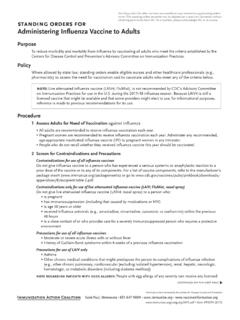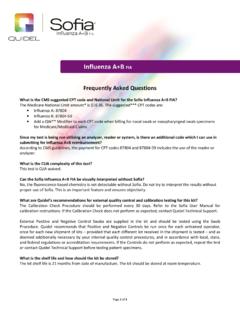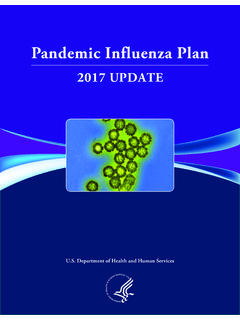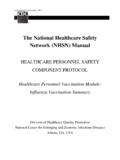Transcription of Recommended composition of influenza virus …
1 2 March 2017 Page 1 of 7 Recommended composition of influenza virus vaccines for use in the 2017- 2018 northern hemisphere influenza season March 2017 The World Health Organization (WHO) convenes technical consultations1 in February/March and September each year to recommend viruses for inclusion in influenza vaccines2 for the northern and southern hemisphere influenza seasons, respectively. This recommendation relates to the influenza vaccines for use in the forthcoming northern hemisphere 2017-2018 influenza season. A recommendation will be made in September 2017 relating to vaccines that will be used for the southern hemisphere 2018 influenza season. For countries in tropical and subtropical regions, epidemiological considerations influence which recommendation (northern hemisphere or southern hemisphere) individual national and regional authorities consider appropriate.
2 Seasonal influenza activity, September 2016 February 2017 Between September 2016 and February 2017 influenza activity was reported in Africa, the Americas, Asia, Europe and Oceania. In general, activity was higher compared with the same period last year. In the southern hemisphere, influenza activity was low in most countries, however, regional outbreaks continued in South Africa during September and in Australia during September and October. In the northern hemisphere, influenza activity began in Asia and Europe in October-November and had increased in most countries by December. In many countries with tropical and subtropical climates, influenza circulated during the entire reporting period. influenza A(H1N1)pdm09 viruses circulated at very low levels with a few exceptions.
3 influenza A(H3N2) viruses were dominant in most countries and regional and widespread outbreaks were reported in Asia, Europe, and North America. influenza B viruses circulated at low levels in most countries throughout the period while regional outbreaks were reported in Asia, western Africa and the United States of America. 1 2 Description of the process of influenza vaccine virus selection and development available at: 2 March 2017 Page 2 of 7 Detailed information by country of the extent and type of seasonal influenza activity worldwide is available on the WHO website: Zoonotic influenza infections caused by A(H5), A(H7N9), A(H7N2), A(H9N2), A(H1)v and A(H3N2)v viruses From 27 September 2016 to 27 February 2017, two human cases of A(H5N6) infection were reported by China and two human cases of A(H5N1) infection were reported by Egypt.
4 Highly pathogenic avian influenza A(H5) is present in poultry in both countries. Since December 2003, a total of 874 human cases of A(H5) infection with 458 deaths have been confirmed in 16 countries. To date there has been no evidence of sustained human-to-human transmission. During this period 460 additional human cases of avian influenza A(H7N9) virus infection have been reported to WHO by China. Since February 2013, a total of 1258 cases with 328 deaths have been reported. One human case of A(H7N2) infection was reported by the United States of America. Three A(H9N2) human cases were reported by China during this period. The virus from one of these cases was recovered and it belonged to the A/chicken/Hong Kong/Y280/97 genetic lineage.
5 During this period, four cases of A(H1)v were reported: one A(H1N2)v by the United States of America and three A(H1N1)v in Europe. One case of A(H3N2)v was reported by the United States of America. Antigenic and genetic characteristics of recent seasonal influenza viruses influenza A(H1N1)pdm09 viruses The vast majority of A(H1N1)pdm09 viruses collected from September 2016 to February 2017 belonged to phylogenetic clade 6B. Most recently circulating viruses belonged to genetic subclade A small proportion of viruses circulating in Asia and Oceania belonged to subclade Antigenic characteristics of A(H1N1)pdm09 viruses were assessed with post-infection ferret antisera in haemagglutination inhibition (HI) assays, which indicated that almost all recent A(H1N1)pdm09 viruses were antigenically indistinguishable from the vaccine viruses A/California/7/2009 and A/Michigan/45/2015 (viruses used in the 2016-2017 northern hemisphere and 2017 southern hemisphere vaccines, respectively).
6 However, circulating viruses were poorly inhibited by some post-vaccination (A/California/7/2009) adult human serum pools. HI assays were used to measure the presence of antibodies to recent A(H1N1)pdm09 viruses in panels of sera from children, adults and older adults who had received seasonal trivalent or quadrivalent inactivated vaccines of the composition Recommended for the southern hemisphere 2016 and the northern hemisphere 2016-2017 seasons (A/California/7/2009 (H1N1)pdm09-like, A/Hong Kong/4801/2014 (H3N2)-like and B/Brisbane/60/2008-like viruses, with the addition of B/Phuket/3073/2013-like antigens for quadrivalent vaccines). Geometric mean HI titres of antibodies against some representative recent A(H1N1)pdm09 viruses were reduced significantly as compared to HI titres to the vaccine virus ; however, reductions were less pronounced for the majority of recent viruses.
7 influenza A(H3N2) viruses The large majority of A(H3N2) viruses collected from September 2016 to February 2017 belonged to the phylogenetic clade and subclade There has been considerable genetic 2 March 2017 Page 3 of 7 diversification of the HA gene within this clade and subclade. A small number of clade viruses were also detected. Antigenic characterisation of viruses continued to be technically difficult because many viruses did not agglutinate red blood cells in the absence or presence of oseltamivir carboxylate, added to circumvent agglutination by the virus neuraminidase. virus neutralisation assays supplemented HI assays for the antigenic characterisation of viruses. Most recent A(H3N2) viruses were well inhibited by ferret antisera raised against cell culture-propagated reference viruses in clade , including A/Hong Kong/4801/2014 or A/Michigan/15/2014 viruses.
8 These antisera also well inhibited the majority of viruses in subclade In human serology studies, using the serum panels described above, geometric mean HI titres of antibodies against many representative recent cell culture-propagated A(H3N2) viruses were reduced significantly compared to HI titres to the egg-propagated vaccine virus . However, no significant reductions in geometric mean titres were observed when compared to cell culture-propagated vaccine or reference viruses. Results were similar in microneutralisation tests using subsets of serum panels and viruses. influenza B viruses influenza B viruses of the B/Victoria/2/87 and the B/Yamagata/16/88 lineages co-circulated in many countries with variable proportions in different regions.
9 All of the HA gene sequences of B/Victoria/2/87 lineage viruses belonged to genetic clade 1A. In HI assays, recent viruses were well inhibited by post-infection ferret antisera raised against either B/Brisbane/60/2008 or B/Texas/2/2013 cell culture-propagated viruses. Almost all of the HA gene sequences of B/Yamagata/16/88 lineage viruses belonged to genetic clade 3. In HI assays, recently circulating B/Yamagata/16/88 lineage viruses were well inhibited by post-infection ferret antisera raised against cell culture- and egg-propagated B/Phuket/3073/2013 viruses (clade 3). In human serology studies, using the serum panels described above, geometric mean HI titres of antibodies against some representative recent B/Victoria/2/87 lineage viruses were reduced compared to HI titres to the egg-propagated vaccine virus B/Brisbane/60/2008; reductions were less pronounced when compared to cell culture-propagated B/Brisbane/60/2008.
10 In studies using serum panels from subjects who had received quadrivalent vaccine , geometric mean titres against representative recent B/Yamagata/16/88 lineage viruses were similar to those against cell culture-propagated vaccine virus B/Phuket/3073/2013; somewhat greater reductions were observed when compared to HI titres to the egg-propagated vaccine virus B/Phuket/3073/2013. Resistance to influenza antiviral drugs Neuraminidase inhibitors The detection of viruses with reduced susceptibility to the neuraminidase inhibitors was very rare among the 4832 viruses tested by the WHO CCs during this reporting period. Of 693 influenza A(H1N1)pdm09 viruses tested, two viruses showed reduced susceptibility. One virus , detected in Australia from a patient treated with oseltamivir, carried an H275Y amino acid substitution in the neuraminidase which conferred highly reduced inhibition by oseltamivir and peramivir.















